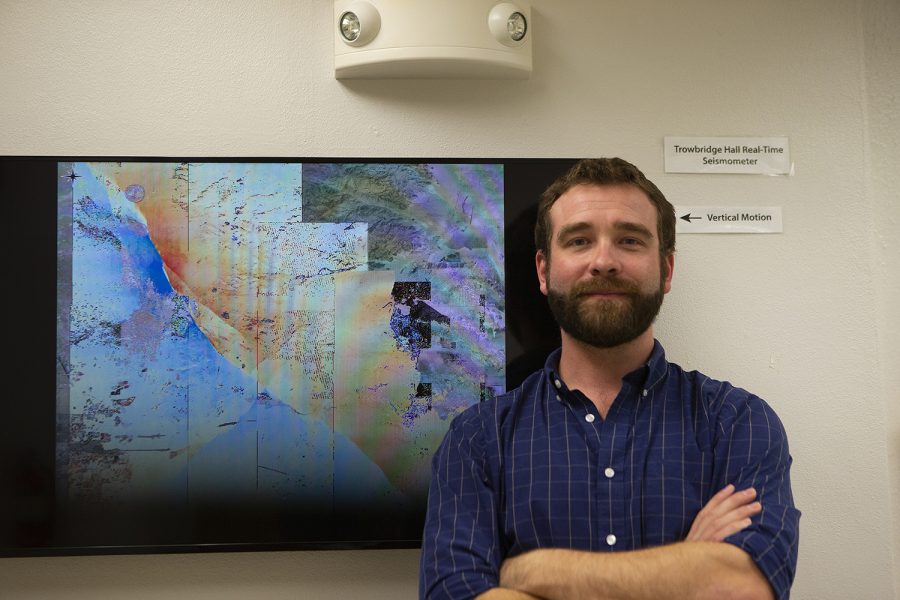UI-led study discovers stress on fault line in Southern California
A University of Iowa-led study found that two earthquakes in Southern California last summer triggered creep on the Garlock Fault Line.
William Barnhart is photographed on Tuesday, November 5, 2019 next to his data. Barnhart took part in the research study on the Garlock Fault in Southern California. (Raquele Decker/The Daily Iowan)
November 7, 2019
Research conducted by a University of Iowa-led team indicates that a series of earthquakes that occurred in Southern California in July triggered stress on the Garlock Fault Line, which has remained dormant for the last century.
William Barnhart, geodesist and assistant professor in the Earth and Environmental Sciences Department, said his team was researching last summer’s earthquakes — called the Ridgecrest earthquakes — because they were of scientific interest due to their magnitude.
The U.S. Geological Survey collaborated on this project as well, and funding for the research came from the Southern California Earthquake Center, Barnhart said.
In the course of its research, Barnhart said, the research team could see that there was a signal on the Garlock Fault that suggested it had moved during the Ridgecrest Earthquakes, despite the fact that the earthquakes didn’t occur on the Garlock Fault. Instead, he said, it was revealed that the fault had undergone “creep,” which is fault slip that doesn’t produce seismic waves.
“An earthquake is [a] slip on a fault that produces seismic waves, and creep is slip on a fault that doesn’t produce seismic waves,” Barnhart said.
The research conducted by the team used satellite imagery and seismic instruments, Barnhart said. Seismic instruments alert researchers that an earthquake has happened by picking up on seismic waves going through the earth, he said. These instruments can also be used to precisely map out where aftershocks happen, Barnhart said.
Through these tools and when a lot of information about an earthquake is available, a model can be formed that shows how it would look underground, he said. From there, simulations can be made that reveal how it changes all the stresses in the Earth around it and model how it stresses the Garlock Fault.
This process revealed that the earthquake alleviated stress on a Garlock Fault for the most part, he said.
“What we found is that, by and large, those Ridgecrest earthquakes actually relieved stresses on the Garlock Fault, which is a good thing,” he said. “Except for this narrow 20-25 kilometer area where it increases increased stresses on the fault, and that’s exactly where we see the creep.”
RELATED: UI professor uses satellites to improve earthquake response
In an email to The Daily Iowan, U.S. Geological Survey Seismologist Gavin Hayes said he found the “stress transfer” and “triggering” to be the most compelling stories within the research. He said the slow slip discovered on the fault confirms past observations in California that these processes are important for understanding earthquakes.
“Studies like this are how our understanding of earthquake processes move forward — we gain a better understanding of earthquakes and earthquake hazard, and these advances ultimately lead to us being better able to mitigate earthquakes and their damage in the future,” Hayes said.
Ryan Gold, co-author of the study and a geologist for the U.S. Geological Survey, was deployed to the field area after the Ridgestone earthquakes occurred, he said. Gold spent about two weeks researching in the field to provide access to high resolution satellite imagery.
He said during the course of the research, it was recognized that the shallow movement across the Garlock fault was a very interesting observation. These findings, Gold said, will be used for years to come when studying earthquakes.
“There is tremendous interest in this earthquake sequence form the global seismology and geology community,” Gold said. “And … it is one of the first studies that provides a nice overview and framework for future research to be developed.”






